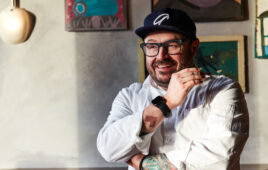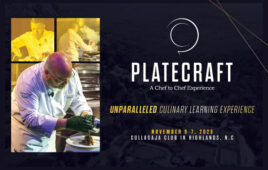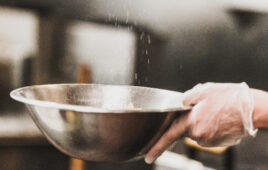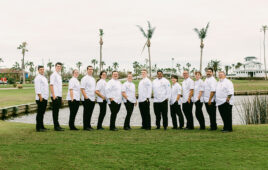 Jennifer Monaco’s perseverance and passion has paid off with solid culinary performance and a respected position as Sous Chef at Manasquan River Golf Club.
Jennifer Monaco’s perseverance and passion has paid off with solid culinary performance and a respected position as Sous Chef at Manasquan River Golf Club.
Manasquan is a Lenape Indian word meaning “Mouth of the River.” Manasquan River Golf Club (MRGC), in Brielle, N.J., is located on 145 scenic acres along the Manasquan River, just a mile or two from the Atlantic Ocean. The club opened for golf in 1923 and quickly attracted a membership that included many prominent families from the greater New York/northern New Jersey region.
Jennifer Monaco, CEC, has been Sous Chef at MRGC for the past eight years under the mentorship of Chef Daniel Palsi, who is well-known thoughout the New Jersey and New York club, restaurant and hotel scene. The F&B team at MRGC is renowned for its inventive approaches to member dining (see “A Sizzling Show, C&RB, April 2010), and Chef Manaco was kind enough to talk to us as the club geared up for another busy season, to help us understand what it’s like to be a high-energy, high-achieving woman culinarian in what’s still a largely male-dominated section of our industry.
Q: Chef, prior to when you came to MRGC, you had some challenging experiences to prove yourself as a female chef. Can you give us a snapshot of the kinds of things that happened, and describe how things may have changed since then?
A: For my very first two restaurant kitchen jobs while home during summer from culinary school, and then for my first job out of culinary college, working for a restaurant’s Pantry and Banquets operation, I had to put up with a lot of negativity, as did other, more seasoned women in the kitchen—we were always being questioned about why we felt the need to work there. I was harassed and made fun of, most of the men did not want to teach me anything, and when I would poke around on the hot line, I was told they did not want me there at all. Even with all of this, though, I loved what I did with the food. I took major overtime to work in the banquet kitchen after hours and was eventually acknowledged by the restaurant owners themselves, who hired me for private affairs, galas, and festivals.
Why do I believe these experiences happened? When you go into any place of business where members of a staff have been with the same group of people and are somewhat set in their ways, they do not want competition. And, because there are not many women who want to have a chance to work on the hot foods side, they are going to use their best tactics to scare you away. I was a joke to many of these men, for no other reason than they thought they had the right to treat me that way.
But having a position isn’t a possession, and you can’t scare people into not wanting to help make a restaurant better. You should embrace new hires and learn from one another, to make each other better chefs. I always say, “There’s always someone out there who’s better than you at what you do,” and stress that it’s important to be humble and always show an interest in continuing to learn. At the same time, while remaining open-minded and willing to change, you have to make it clear that you won’t take unwarranted abuse from anyone, or let anyone tell you that you can’t do something.
I do think that women in the industry are becoming more accepted, especially since so many talented female chefs have recently been showcased in the public eye, such as Cat Cora on Iron Chef, Lidia Bastianich, and the contestants on shows like “Top Chef” and “Chopped.” Is it still rare and unexpected when you see a female executive chef and sous chef? Yes—but I think more people are coming to see talent as just that, and not making judgments based on gender as much as in the past.
Q: A survey in 2003 of the enrollment at The Culinary Institute of America showed that women made up 44% of the school’s students, and this was a huge increase from previous decades. But in my mind, that number doesn’t tell the entire story, because the same survey showed that 80% of the pastry students at CIA are women, and only 4% of all executive chefs in America are women. Why do you think more women choose the pastry arts?
A: I do in fact see a lot of women in the pastry arts, and I applaud anyone who is talented enough to do some of the magnificent artistry within that field. I for one am not a pastry chef—and though I have recently decided to start taking more educational courses and possibly go back for a pastry certificate, I must admit it’s something my heart is just not into as a career. I am a hot foods chef, and have always wanted to be.
I do not come across many women, whether starting out or accomplished, who apply for culinary areas outside of pastry. Is this something that more women are geared towards because they have more of a knack for the little details and touches? Are they too afraid to get their makeup messed up behind the hot line, when you have to work with no air conditioning in front of four 500-degree ovens, a grill and a steamer? Or is it because they are not really given the chance to prove themselves in other areas of the culinary field, such as in hot foods?
I don’t have the answer, and I’m sure that if you could survey all of the female pastry chefs, you’d get a million different answers. And while some of these suggested answers may seem stereotypical, they are unfortunately valid questions that occur to many people when they look at the culinary industry and the differences between males and females in the kitchen.
In February of 2010, I did a kitchen demonstration for the Culinary Arts students at Perth Amboy Vocational High School. I was specifically brought in because more than half of the class was made up of young woman who had seen me do my CEC testing at that site. After many of them saw that I was the only woman doing the test out of a dozen chefs, the instructor said a number of the students asked him why I was not in pastry; it was clear these young girls thought that is what women in the industry should automatically go into, and if they also got a chance to work on the line, so be it.
My one fear is that I hope many women do not chose pastry simply because they are afraid to put up a fight for what they want. If you want to do sauté, work the grill, or run banquets, then set that goal and get it! State your intentions during interviews right away. Work garde manger or even prep, and then start poking around on the line when it is slow. Find someone who is willing to teach you, and have them take you under their wing. It may take years and a lot of sweat and tears, but the culinary field is all about trying new things and continuous education.
So until you’re fully experienced, you shouldn’t let yourself get “stuck” in a position you do not like, or think that it is what you were “meant to do.” If you keep at it, you’ll eventually get a chance to shine, and succeed.
Q: You’ve said your opinion is always heard as a Sous Chef at Manasquan River, and that you have the freedom to express your creativity in menu design. This is an obvious credit to you and your chef. What can you tell others who need to develop this type of relationship?
A: The first and ultimate area for developing any relationship is to learn respect. This does not mean just saying yes chef, no chef, thank you, etc. It has to do with being a true professional to everyone around you, whether it is within the kitchen, with the front of the house, management, the caddies, whomever. Respect is giving credit to everyone for doing their job the best way they can with the tools that are given to them, even if you might not agree with some of their methods.

Success comes from not shying away from any challenge that might be found in the kitchen, Chef Monaco says, and in savoring the quest to always find new ways to produce creative results.
Respect leads to trust, and with the fantastic leadership of my Head Chef and General Manager, I have learned the skills and methods needed for the success of our business, and gained the trust and appreciation of my staff. As with any relationship, there always has to be “give and take” to develop confidence and dependability for each other. I know my chef’s standards and it is my job to make sure that we meet and exceed them; just as importantly, our staff knows those standards as well, and also knows that I carry an even higher level of expectation, to make sure the chef will be happy.
We acknowledge and recognize the talents and goals of each member of our staff, and give each the freedom to express their creativity through menu development, specials, and by simply trying out new ideas for events, while staying specific to the dishes we have standardized. We trust our cooks, because each of them has a passion for what the business is all about. It is a great environment for seeing your thoughts and ideas come to life when given a chance, and makes the long, hard hours of a very stressful job more fun.
Q: Chef, your staffing strategy going into peak season has changed to hiring more part-time employees, instead of replacing the full-timers that have gone back to school or relocated. Is the rising cost of benefits the main reason for this?
A: The cost of benefits does play a part in why we have not hired back more full- time employees, but I would not say that is the main reason itself. As many other clubs, resorts, and restaurants know, there is often (depending on location) a busy season and your slow time. The main reasoning behind not hiring so many full time employees as new hires has to do with the fact that they are not necessarily needed all year round. From May to October, we need bodies! But when things slow down in January, February and March, there aren’t going to be enough hours for each individual on a full-time basis. So we have strictly seasonal employees, and this helps balance out the payroll and cut back costs, because these individuals do not get benefits. At times we also find it better to have some overtime for our full-time cooks, rather than add part-time people who may not be as acclimated in certain areas.
Q: Chef, congratulations on the CEC accomplish ment. Can you run us through the certification process and give some tips to those who are thinking about going for it?
A: I was extremely excited to get my CEC in 2009. As with anything else, this was a very high goal that I set for myself; it just felt right to make this the next accomplishment, after finally earning my Bachelors of Science, which had taken me six years to complete online while working full-time.
I was lucky enough to have taken the CC tests when I first graduated The Academy of Culinary Arts, as well as having plenty of competition experience under my belt. That all helped to make me more aware of what the judges were going to be looking for as far as knife cuts, cooking processes, sanitation and timing. I put my heart and soul into the CEC test: preparing recipes, practicing at the testing site, getting input from many of the ACF members who were involved, and putting together an extensive list of my timing for the day so I could be as prepared as possible….this test was taken seriously.
For those going for any certification, that’s the first thing I would suggest: take it seriously. I see many chefs who seem to take these tests and courses just to get the title, which is a shame; this is something to learn a lot from, and be proud of! Continuous education is key, as well as reviewing the basics when taking the written exams.

Manasquan River Golf Club, which opened for golf in 1923, sits on 145 scenic acres just a short distance from the Atlantic Ocean.
As for the practical tests, my biggest piece of advice would be to practice, ask for help from someone who has an inside view on what the judges are going to be looking for, research, develop – and deliver. When you practice, focus on the time limits given—you don’t want to assume you have time to poach and break down four lobsters, only to realize too late during the actual test that it has put you in the weeds. Also, don’t come up with too complicated of a menu! Include the cuts and cooking techniques that they ask for, and make sure everything tastes good—and remember, sometimes simpler is better.
One last piece of advice would be to find short cuts that can help you remember everything there is to do that day! For me, I noticed that a proper large dice was the size of my thumb nail and that a proper julienne was the size of the white of my pinky nail. I also made a timeline and check list of every single thing that needed to be accomplished, starting with 1) turn on ovens, 2) bring water and stocks to a boil, and so on. Finally, if you don’t succeed the first time, try again! Take the first experience and see what you can change, and focus on those aspects that will lead to better results the next time.
Q: Jennifer, you attended the Chef to Chef Conference in San Francisco in March and said that it helped you come back to New Jersey energized and ready to start a new season. What did you take away from the experience, and what can you tell those who are considering going in 2012?
A: Going to the Chef to Chef Conference was a great experience, and I cannot wait to attend again in the future. It was nice to be surrounded by such experienced and well-rounded professionals within the club and resort industry. This made for a great atmosphere for sharing stories and experiences, brainstorming, and coming up with new ideas that were innovative and practical.
The demonstrations themselves were outstanding and very well-balanced, covering every area of what management and chefs need to know to better themselves and their club. The sessions on topics such as cost analysis; finding out what a GM wants from a chef; how to profit from baking without a pastry chef on premise; and learning about sustainability all covered major areas that hit home with so many chefs.
It was also nice to see that I could relate to a lot of the notes from each lecture, which made me more confident that our club has been proactive in doing a lot of the things that are now considered “correct,” such as small portions, farm-to-table dinners, themed nights, newsletters and e-mail blasts.
View some of Chef Monaco’s recipes, including:





